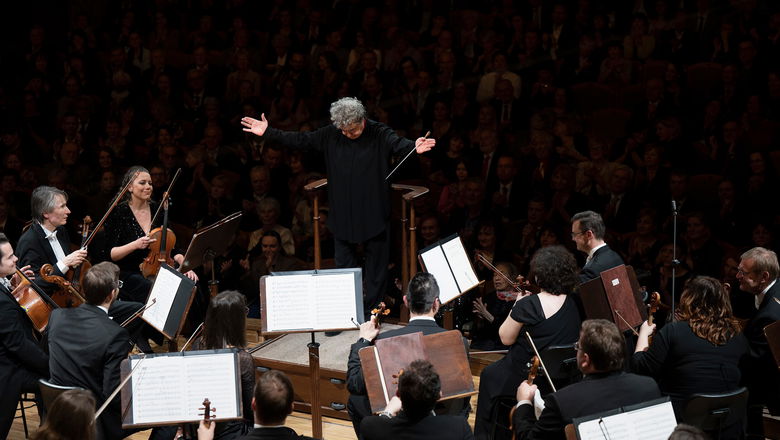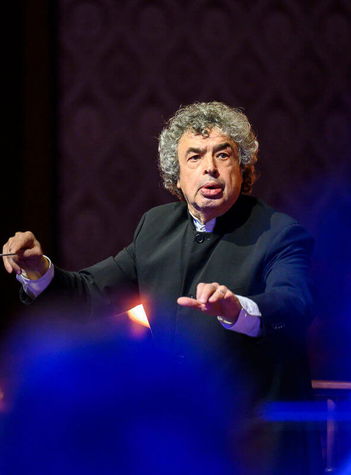Programme
Dmitri Shostakovich
Symphony No. 7 in C major, Op. 60 “Leningrad” (73')
Unmistakable and still highly relevant—Shostakovich’s Seventh Symphony, first heard during the siege of Leningrad in 1942, is a key work in Bychkov’s repertoire. One reason is his familial connection to Leningrad of that era, and a second is the conductor’s love of Shostakovich’s works for their authenticity and close ties to Russian history.
Subscription series A | Duration of the programme 1 hour 15 minutes
Dmitri Shostakovich
Symphony No. 7 in C major, Op. 60 “Leningrad” (73')
Semyon Bychkov conductor
Czech Philharmonic

“The genius of this symphony lies precisely in the fact that it is not descriptive. At no point do you hear, for example, "Here the German tanks have turned left... Art is there to evoke a state or a feeling. And that's what Shostakovich managed to do, to find sounds and tones that evoke in us an unwavering feeling that we know what it's about. This is what one sees, feels and hears in Shostakovich's Seventh Symphony - all aspects of life from happiness to hope to fear, destruction, good and evil.”
— Semyon Bychkov, Chief Conductor
Semyon Bychkov conductor

In addition to conducting at Prague’s Rudolfinum, Semyon Bychkov and the Czech Philharmonic in the 2023/2024 season, took the all Dvořák programmes to Korea and across Japan with three concerts at Tokyo’s famed Suntory Hall. In spring, an extensive European tour took the programmes to Spain, Austria, Germany, Belgium, and France and, at the end of year 2024, the Year of Czech Music culminated with three concerts at Carnegie Hall in New York.
Among the significant joint achievements of Semyon Bychkov and the Czech Philharmonic is the release of a 7-CD box set devoted to Tchaikovsky’s symphonic repertoire and a series of international residencies. In 2024, Semjon Byčkov with the Czech Philharmonic concentrated on recording Czech music – a CD was released with Bedřich Smetanaʼs My Homeland and Antonín Dvořákʼs last three symphonies and ouvertures.
Bychkovʼs repertoire spans four centuries. His highly anticipated performances are a unique combination of innate musicality and rigorous Russian pedagogy. In addition to guest engagements with the world’s major orchestras and opera houses, Bychkov holds honorary titles with the BBC Symphony Orchestra – with whom he appears annually at the BBC Proms – and the Royal Academy of Music, who awarded him an Honorary Doctorate in July 2022. Bychkov was named “Conductor of the Year” by the International Opera Awards in 2015 and, by Musical America in 2022.
Bychkov began recording in 1986 and released discs with the Berlin Philharmonic, Bavarian Radio, Royal Concertgebouw, Philharmonia Orchestra and London Philharmonic for Philips. Subsequently a series of benchmark recordings with WDR Symphony Orchestra Cologne featured Brahms, Mahler, Rachmaninov, Shostakovich, Strauss, Verdi, Glanert and Höller. Bychkov’s 1993 recording of Tchaikovsky’s Eugene Onegin with the Orchestre de Paris continues to win awards, most recently the Gramophone Collection 2021; Wagner’s Lohengrin was BBC Music Magazine’s Record of the Year (2010); and Schmidt’s Symphony No. 2 with the Vienna Philharmonic was BBC Music Magazine’s Record of the Month (2018).
Semyon Bychkov has one foot firmly in the culture of the East and the other in the West. Born in St Petersburg in 1952, he studied at the Leningrad Conservatory with the legendary Ilya Musin. Denied his prize of conducting the Leningrad Philharmonic, Bychkov emigrated to the United States in 1975 and, has lived in Europe since the mid-1980’s. In 1989, the same year he was named Music Director of the Orchestre de Paris, Bychkov returned to the former Soviet Union as the St Petersburg Philharmonic’s Principal Guest Conductor. He was appointed Chief Conductor of the WDR Symphony Orchestra (1997) and Chief Conductor of Dresden Semperoper (1998).
Dmitri Shostakovich
Symphony No. 7 in C Major, Op. 60 (“Leningrad”)
Allegretto
Moderato (poco allegretto)
Adagio
Allegro non troppo
In the life of Dmitri Shostakovich, the Second World War came on the heels of a period that was no less dramatic. In the latter half of the 1930s during the “Great Purge”, the Stalin regime rid itself of more than a million of its ideological enemies amongst intellectuals, politicians, and members of the military. These events drastically afflicted Shostakovich’s birthplace Leningrad. The victims of the political terror included Shostakovich’s friends the stage director Meyerhold and Marshal Tukhachevsky. After Stalin attended the opera Lady Macbeth of the Mtsensk District in January 1936, an article appeared in Pravda with the notorious headline Muddle Instead of Music, and it seemed that Shostakovich’s arrest was inevitable. Ultimately he was not arrested either before or after the war, but fear and anxiety pursued the composer nearly to the end of his life. Stalin’s relationship with Shostakovich was almost incomprehensibly ambivalent, and that relationship was also an important factor in the composer’s life and work. Stalin subjected Shostakovich to public humiliation and harassment while at almost the same time showering him with the highest honours and titles.
Shostakovich himself said he began thinking about the seventh of his 15 symphonies even before the war, and when the Germans arrived at the edge of Leningrad in early September 1941, the first movement was already finished, and he was hard at work on the others. During the months that followed, he wrote the next two movements in the besieged city, then he finished the finale in Kuybyshev (today Samara), where he and his whole family had been evacuated in the middle of October, and where the Seventh Symphony was first performed in March 1942. Soon after the premiere, the story of this work began to live a life of its own, and Stalin’s propaganda tirelessly exploited the work’s image as a symbol of the German occupation and of Russian resilience. It is not without interest that the composition very quickly became popular in the countries of the Western allies as well, and it served their purposes as part of their anti-Hitler political marketing. Ultimately, it was the famed conductor Arturo Toscanini who won the hotly contested rights for the first Western performance, and the symphony was first heard on American soil almost a month before it was heard in Leningrad itself. The popularity of the Seventh Symphony was soon carried over to the person of the composer himself, and it is likely that this attention from the West fanned the flames of Stalin’s intolerance.
Shostakovich himself took little interest in the spontaneous popularity of this work. Through no fault of the composer, the Leningrad Symphony had been turned into a political tool that had little if anything to do with his personal convictions. It is paradoxical that the war of all things gave Shostakovich an opportunity to delve fearlessly into the feelings that had been troubling him long before the German invasion. This is also documented by the words of the author Ilya Ehrenburg, who recalled the wartime years as a period of relative creative freedom for Soviet artists: “It was possible to portray sorrow and destruction”. Shostakovich often spoke of his symphonies including the Seventh as requiems for all the heroes who were never honoured. “The majority of my symphonies are tombstones. Too many of our people died and were buried in places unknown to anyone. I’m willing to write a composition for each of the victims, but that’s impossible, and that’s why I dedicate my music to them all.”
In Leningrad, the city that gave the symphony its name, the circumstances of the first performance were extraordinarily dramatic. At the time, the Germans had already kept Leningrad under siege for nearly a year with devastating effects, and its residents were suffering from the lack of everything a person needs to survive, from food to electricity. Already by then, the number of victims was in the hundreds of thousands. The only orchestra that remained in the city was the Leningrad Radio Orchestra led by the conductor Karl Eliasberg. Of the ensemble’s original 40 members, only about 15 remained; the rest had died of hunger or were sent to the front. Nonetheless, performing the symphony there was a matter of the highest priority, so even the top authorities in Leningrad made every effort to ensure that the concert took place. Understandably, the musical quality of the performance was not comparable to earlier ones whether in Russia or the USA. The atmosphere, however, was unique. The ovation lasted nearly an hour, and people were weeping. “Some wept because it was the only way to express their emotion, others heard a reflection of their everyday lives in the music, still others were weeping for those they had lost, and some were just moved that they were able to go to the Philharmonia and listen to music”, wrote the historian Anna Reid, quoting one of the witnesses. The concert was broadcast on the radio, and according to available reports, among those listening were even the German soldiers outside the city. Many years later, a few of them sought out the conductor Eliasberg and reminisced about that day: “When we heard this music, we said to ourselves—for God’s sake, who is it that we are bombarding? We realised that we could never conquer Leningrad. Its inhabitants were driven by a powerful will to survive that was mightier than hunger, fear, and death.”
Initially, the composer gave programmatic titles to the individual movements of the symphony, but he soon crossed them out, so only the tempo indications of the movements remained. Shostakovich was very opposed to the Leningrad Symphony being interpreted as a musical description of the German occupation. That does not mean, however, that there is even a single bar of the composition that is not permeated by the war. Before Shostakovich abandoned Leningrad, he played the first three movements on the piano for his friends the theatre critics Isaak Glikman and Ivan Sollertinsky with the noise of the ongoing bombardment in the background. During the discussion afterwards, all three realised how remarkably the music corresponded to the environment in which they were then living.
The Leningrad Symphony is one of Shostakovich’s longest works. The first movement alone lasts nearly 30 minutes, and the whole symphony is about an hour and a quarter long. The first movement, Allegretto, begins with a majestic theme in the strings accompanied by the woodwinds. The opening is followed by a calmer passage dominated by a lyrical line for the flute and ending with a dialogue between the piccolo and a solo violin. The most famous passage of the entire symphony now arrives abruptly: a rhythmical march theme with a structure reminiscent of Ravel’s Bolero and a melody based on the tune of a popular aria from Lehár’s operetta The Merry Widow. That fact is seemingly the origin of the frequent interpretation of the “march” as the motif of the German invasion. The 22-bar theme is repeated 12 times, and the instrumentation and dynamics build up gradually, growing into the monumental sound of the full orchestra. The opening sequence familiar from the beginning of the movement now returns with the majestic passage followed by the lyrical episode, now represented by a bassoon solo. The opening theme is heard again, then the march motif returns in the brief coda, this time played only by percussion and solo trumpet.
The two middle movements, Moderato (poco allegretto) and Adagio, are very similar in mood: lyrical and calm, evoking nostalgia. In the second movement, there are discernible dance rhythms, while according to Shostakovich, the third movement is intended to depict Leningrad with the sun setting on its streets and the banks of the Neva. The fourth movement, Allegro non troppo, begins with a quiet melodic theme played softly, but the thunderous sound of the full orchestra soon makes itself heard. The character of the finale is fierce, determined, and victorious. The triumphantly optimistic forte in C major is disturbed only by the worrying sound of drums and tympani in the background—evil is still present, and one must remain on guard against it.